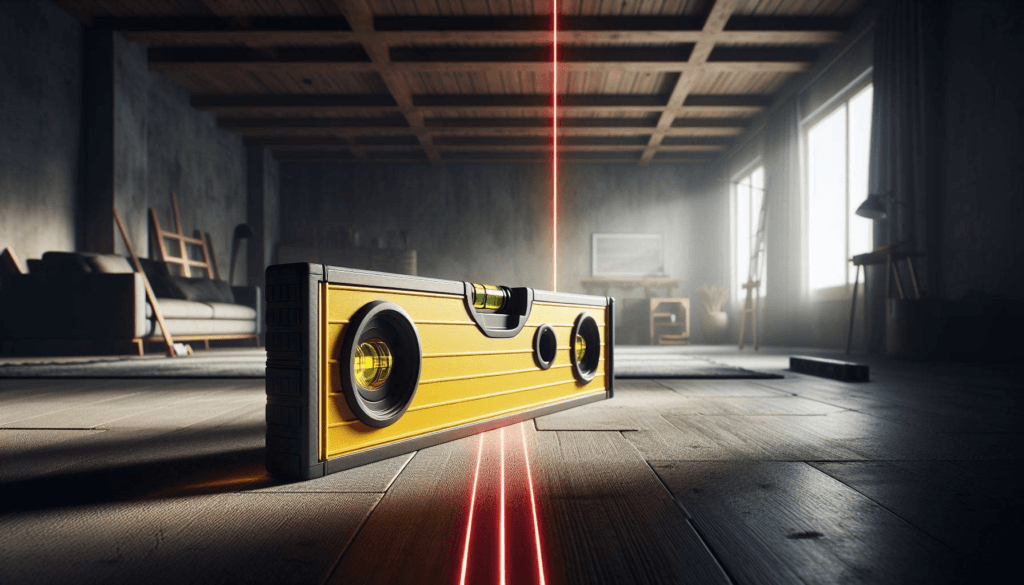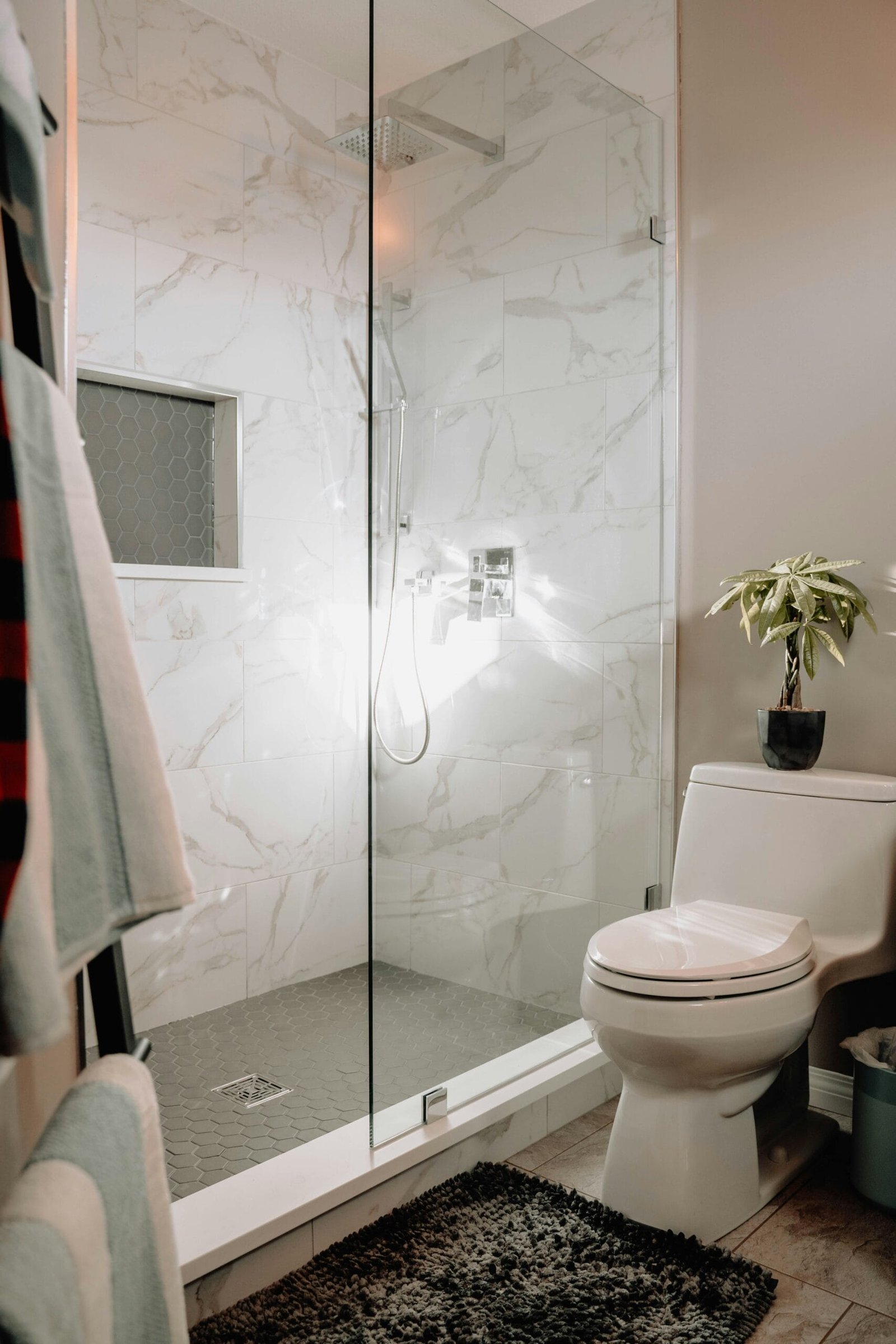Understanding the Basics of a Laser Level
Before we delve into the specifics of using a laser level for perfectly straight lines, let’s first understand the basics of this incredibly useful tool. A laser level is a device that projects a visible laser beam onto a surface, providing a straight and level reference point. It is commonly used in construction, woodworking, tiling, and other tasks that require precision and accuracy.

Please, read our post and do not forget to check the YouTube channel “Home RenoVision DIY”:
https://www.youtube.com/@HomeRenoVisionDIY
How Do I Use My Laser Level? (video)
Choosing the Right Type of Laser Level
When it comes to using a laser level for perfectly straight lines, selecting the right type of laser level is crucial. There are various types of laser levels available, including dot lasers, line lasers, and rotary lasers. Each type has its own specific applications, so it’s essential to choose the one that best suits your needs.
If you’re working on indoor projects such as hanging pictures or installing shelves, a simple line laser level will suffice. On the other hand, if you’re tackling outdoor projects or large construction tasks, a rotary laser level that projects a 360-degree line is more appropriate.
Calibrating the Laser Level
Before using a laser level to achieve perfectly straight lines, it’s important to ensure that the device is properly calibrated. Calibration helps in guaranteeing the accuracy of the laser beam, which is essential for achieving precise results.
Most modern laser levels come with easy-to-follow calibration instructions. Typically, this involves setting the device on a stable surface, ensuring it is perfectly level, and then following the specific steps outlined in the user manual. Some laser levels may also have self-leveling capabilities, making the calibration process even more straightforward.
Using the Laser Level for Perfectly Straight Lines
Now that you have a good understanding of laser levels and have calibrated your device, it’s time to explore how to use it for creating perfectly straight lines.
Step 1: Positioning the Laser Level
Start by positioning the laser level at the starting point of the line you want to create. Ensure that the device is stable and secured in place, as any movement during operation can affect the accuracy of the line.
Step 2: Activating the Laser Beam
Once the laser level is securely positioned, activate the laser beam. Depending on the type of laser level you’re using, this may involve simply pressing a button or engaging a specific setting. As soon as the laser beam is activated, it will project a straight line onto the surface, serving as a visual guide for your task.
Step 3: Making Adjustments
If the laser level allows for adjustments, such as changing the angle or height of the laser line, make any necessary modifications to ensure that it aligns perfectly with your desired straight line. This step is crucial for achieving precision, especially when working on projects that require multiple parallel lines or specific angles.
Step 4: Marking the Line
With the laser line clearly visible, use a pencil or masking tape to mark the path of the line on the surface. This will serve as a guide for your actual work, whether it involves installing tiles, hanging wallpaper, or any other task that demands straight lines.
Step 5: Verifying the Accuracy
Before proceeding with your project, take a moment to verify the accuracy of the marked line by using a traditional level or measuring tape. This extra step ensures that the line created by the laser level is indeed perfectly straight and aligned according to your requirements.
Additional Tips for Using a Laser Level
While the basic steps outlined above cover the fundamental process of using a laser level for perfectly straight lines, there are a few additional tips that can further enhance your experience with this tool.
Firstly, always work in a well-lit environment, as this ensures better visibility of the laser line. If you’re working outdoors or in bright conditions, consider using a laser detector to aid in locating the laser beam accurately.
Furthermore, be mindful of the laser level’s battery life, especially for prolonged projects. Keeping spare batteries on hand or opting for a rechargeable laser level can prevent interruptions during your work.
Lastly, familiarize yourself with the specific features and capabilities of your laser level. Many modern laser levels offer additional functions such as pulse mode for outdoor use, remote control operation, and the ability to project lines at various angles. Understanding and utilizing these features can significantly expand the versatility of your laser level.
Conclusion
In conclusion, utilizing a laser level for creating perfectly straight lines is a straightforward yet essential skill for anyone involved in construction, carpentry, or DIY projects. By understanding the basics of laser levels, choosing the right type for your task, calibrating the device, and following the simple steps for achieving straight lines, you can elevate the precision and quality of your work. With the right technique and attention to detail, a laser level becomes an indispensable tool for ensuring accuracy and efficiency in a wide range of projects.
Mastering Vertical Alignment with a Laser Level
While using a laser level for creating perfectly straight horizontal lines is a common application, it can also be incredibly useful for achieving precise vertical alignment. Whether you’re hanging shelves, installing drywall, or aligning door frames, a laser level can be a game-changer in ensuring everything is perfectly plumb and level.
Vertical Alignment Basics
The concept of vertical alignment refers to the perpendicular orientation of an object or surface relative to the ground. In other words, it ensures that something is perfectly upright and not leaning to one side. Achieving accurate vertical alignment is crucial for the structural integrity and aesthetic appeal of many construction and home improvement projects.
Just as with horizontal lines, a laser level can be an invaluable tool for establishing and verifying vertical alignment. By projecting a laser beam in a vertical plane, the device provides a precise reference point that can be used to align walls, shelves, cabinets, and a wide range of other vertical elements.
Selecting the Right Laser Level for Vertical Alignment
When it comes to using a laser level for vertical alignment, the type of laser level you choose can significantly impact the accuracy and ease of use. Some laser levels are specifically designed with vertical alignment in mind, featuring additional features and functionalities that make the process more efficient.
One such type of laser level is the cross-line laser, which projects both a horizontal and a vertical laser line, intersecting at a 90-degree angle. This allows you to simultaneously establish both horizontal and vertical references, making it ideal for tasks that require precise alignment in multiple planes.
Another option is the rotary laser level, which can be particularly useful for larger projects or outdoor applications. These laser levels emit a 360-degree rotating laser beam, providing a continuous reference line that can be used for both horizontal and vertical alignment.
Regardless of the specific type of laser level you choose, it’s important to ensure that the device is capable of projecting a clear, visible, and accurate vertical laser line to meet your alignment needs.
Preparing the Work Area for Vertical Alignment
Before using a laser level for vertical alignment, it’s important to prepare the work area properly. This ensures that the laser beam has a clear and unobstructed path, allowing for accurate and reliable results.
Start by clearing the area of any obstacles or debris that could interfere with the laser beam’s path. This might include moving furniture, securing loose cables, or removing any objects that could block the laser line.
Next, ensure that the surface where you’ll be using the laser level is clean and free of any obstructions. This is particularly important when working on walls, as any dust or debris can affect the visibility and accuracy of the laser line.
Finally, make sure the laser level is positioned in a stable and secure location, with a clear line of sight to the area where you’ll be working. This may involve using a tripod or other mounting accessories to ensure the device remains stationary during the alignment process.
Aligning Vertical Surfaces with a Laser Level
Once you’ve prepared the work area and selected the appropriate laser level, it’s time to start aligning vertical surfaces. Here’s a step-by-step guide to help you achieve precise vertical alignment using a laser level:
Step 1: Position the Laser Level
Begin by placing the laser level in a strategic location that allows the vertical laser line to be projected onto the surface you need to align. Ensure that the device is level and secure, either by using a tripod or by firmly positioning it on a stable surface.
Step 2: Activate the Vertical Laser Line
Turn on the laser level and activate the vertical laser line function. Depending on the model, this may be a dedicated button or a setting you need to select. Make sure the vertical laser line is clearly visible and projected onto the surface you’re working with.
Step 3: Align the Vertical Surface
With the vertical laser line serving as your guide, position the vertical surface (such as a wall, shelf, or door frame) so that it aligns perfectly with the laser line. Use a level or other tools to ensure the surface is plumb and perpendicular to the ground.
Step 4: Secure the Vertical Surface
Once the vertical surface is properly aligned, secure it in place using the appropriate fasteners or mounting hardware. This could involve screwing in brackets, nailing in studs, or using adhesive to hold the surface in the desired position.
Step 5: Verify the Alignment
After securing the vertical surface, double-check the alignment by carefully observing the laser line. Ensure that the surface remains perfectly aligned with the laser beam throughout its entire length. If any adjustments are needed, make them before the surface is fully secured.
Specialized Techniques for Vertical Alignment
While the basic steps outlined above cover the fundamental process of using a laser level for vertical alignment, there are some specialized techniques and applications that can further enhance your skills and efficiency.
Aligning Multiple Vertical Surfaces
When working on projects that require aligning multiple vertical surfaces, such as installing a series of shelves or hanging a group of picture frames, using a laser level can be incredibly helpful. By projecting a continuous vertical laser line, you can ensure that all the surfaces are perfectly aligned, creating a cohesive and visually appealing arrangement.
To achieve this, position the laser level in a central location that allows the vertical laser line to span the entire area where the multiple surfaces will be installed. Then, use the laser line as a reference to align each individual surface, ensuring they are all perfectly plumb and evenly spaced.
Transferring Measurements Vertically
Another useful application of a laser level for vertical alignment is transferring measurements from one location to another. This can be particularly helpful when working on projects that require precise vertical dimensions, such as installing cabinets, aligning door frames, or mounting fixtures at specific heights.
Simply position the laser level at the desired height and project the vertical laser line onto the surface where you need to transfer the measurement. Then, use a tape measure or ruler to mark the corresponding height on the target surface, ensuring accurate vertical alignment.
Outdoor Vertical Alignment
While using a laser level for indoor vertical alignment is relatively straightforward, working outdoors can present some additional challenges. The impact of sunlight, wind, and other environmental factors can make it more difficult to clearly see the laser line and maintain accurate alignment.
To overcome these challenges, consider using a laser detector or a laser level with a pulse mode feature. Laser detectors are specialized devices that can pick up the laser line even in bright outdoor conditions, allowing you to easily identify the reference point for your vertical alignment. Pulse mode, on the other hand, causes the laser beam to flash at a higher frequency, making it more visible in bright environments.
Maintaining and Caring for Your Laser Level
To ensure that your laser level continues to provide accurate and reliable results for both horizontal and vertical alignment, it’s essential to properly maintain and care for the device. Here are some tips to help you keep your laser level in top condition:
Calibration and Accuracy Checks
Regularly calibrating your laser level and performing accuracy checks is crucial for maintaining its precision. Follow the manufacturer’s instructions for calibrating the device, and consider doing a quick accuracy check before each use, especially if the laser level has been subjected to any impacts or extreme environmental conditions.
Cleaning and Storage
Keep your laser level clean and free of debris by wiping the exterior and lenses with a soft, lint-free cloth. Avoid using any abrasive cleaners or materials that could scratch the device’s surfaces. When not in use, store the laser level in a protective case or storage bag to prevent dust, moisture, and other potential hazards from affecting its performance.
Battery Maintenance
Ensure that the laser level’s batteries are in good condition and replace them as needed. Depleted or low-quality batteries can cause the device to malfunction or provide inaccurate results. Consider using rechargeable batteries or keeping a set of spare batteries on hand to avoid interruptions during your work.
Handling and Transportation
Be gentle when handling your laser level, as excessive force or impacts can damage the internal components and affect the device’s accuracy. When transporting the laser level, use the provided carrying case or a padded container to protect it from shocks and vibrations.
Conclusion
Mastering the use of a laser level for both horizontal and vertical alignment can be a game-changer for a wide range of construction, home improvement, and DIY projects. By understanding the basics of laser level operation, selecting the right type of device, and following the proper techniques, you can achieve perfectly straight lines and precise vertical alignment with ease.
Remember to always prioritize safety when using a laser level, and follow the manufacturer’s instructions to ensure the device is properly calibrated and maintained. With practice and attention to detail, you’ll soon be able to harness the power of laser technology to create flawless, professional-looking results in your projects.
Other related posts from our website:
https://howtobuildahouseblog.com/how-to-choose-the-right-garden-planting-tools/
https://howtobuildahouseblog.com/how-to-be-safe-when-working-with-power-tools/
https://howtobuildahouseblog.com/how-to-bend-copper-pipes-with-or-without-tools/
Thank you so much for your attention.
Stay tuned. We will upload many other amazing posts to our website and videos onto our YouTube channel.
Thank you so much.
for your time and attention.
Best Regards
See you to another post,
Bye, Bye



No Responses